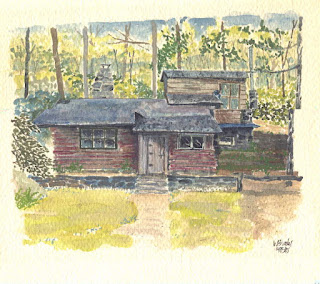A vehicle to display my work; talk about influences on my work; talk of others' works that get my attention - Prints of some of my work on sale at https://www.artpal.com/Willbrady/
2022-06-28
Acrylic: Mountain Range study
Some have asked why I don't work entirely on a single project before starting something else.
Simple - it may be that I'm working on color studies, or certain brush strokes, or perspective (or something else) in order to more suitably complete the other work.
That said, here's a quick landscape study.
Labels:
#©2021WillBrady,
#acryliconcanvas,
#colorstudy,
#mountainrange
Watercolor: Leaving Belize
Labels:
#©2021WillBrady,
#Belize,
#pleinair,
#seacruise,
#sunset,
#watercolor
2022-06-21
Keeseville - Gateway to the Adirondacks
This map was created on spec for a tourism plan for the village of Keeseville, NY. It never got used by the agency that asked for it, however it provides an example of an interpretive map project, combinging illustraion and text related to the village itself. The piece was eventually purchased and is now owned by a private collector who lives in Nrthern New York.
Labels:
#©2021WillBrady,
#InterpretiveMaps,
#KeesevilleNY,
#Tourism
"History Lesson"
Identifying a handful of locations where Black people were massacred in the name of white supremacy. At least three sites were thriving Black communities that were destroyed; two (Tusla OK, and Ocoee FL) were by Ku Klux Klan members - one a direct assault intended to prevent black citizens from voting in 1920. The other (Seneca Village)m was destroyed by bureacuratic intervention/
Acrylic on wood panel in shadow box. 12"x20"/30.5x50 cm (c) 2021 Will Brady
Hunting Cabin - Whigville CT
Two versions of the same site, one a watercolor on paper; the other acrylic on canvas.
I tend to paint "dry"
Labels:
#(c)2022willbrady,
#acrylic,
#cabin,
#huntingcabin,
#watercolor
2022-06-13
First Church, East Haddam CT - looking from Venture and Meg Smith's Gravesites
Venture Smith was a prominent member of the East Haddam and Haddam communities in the early 19th Century. Venture Smith was an African-American farmer and craftsman. Yet, except for his own accounts, there seems little to document his contributions to Haddam Neck and East Haddam. This painting of First Church, Congregational, is thus symbolic perhaps. His family burial area at the cemetery adjacent to the Church is prominent and overlooks to the sanctuary. In his early sixties, he was unjustly charged with the loss of a white man's property and charged for ten pounds while visiting New London. Although being absent from the scene with witnesses, he was still prosecuted. Smith then carried this matter to other courts, claiming his innocence, but the judgment was never reversed. This misleading judgment was made out of discrimination against Black people. Remembering this experience, he said: "Captain Hart was a white gentleman, and I a poor African, therefore it was all right, and good enough for the black dog.[9] " It would not be surprising, then, that even though he achieved financial success before he died, that - as an African man - the powers-that-be kept a certain social isolation between the white settlers and Smith. Just like the stone wall keeps the Smith family gravesites apart from the European area settlers. |
 |
Smith experienced multiple personal setbacks. He bought an enslaved Black man for 400 dollars. However, he wanted to return to his old enslaver, so Smith released him. Venture Smith purchased another enslaved Black man for 25 pounds. After his daughter, Hannah was married, she came down with an illness. However, her husband did not pay adequate attention to her health. Although Smith nursed her, she died. In 1775, Smith bought a farm at Haddam Neck, on the Salmon River, in Connecticut. By 1778 he had expanded the initial 10 acres to form a farm of at least 130 acres. Additionally, he made a living by fishing, whaling, farming his land, and trading in the Long Island basin. He lived the remainder of his life at Haddam Neck.[1] |
(Birth name: Broteer Furro) (c. 1729 – 1805)
Venture Smith (Wikipedia) https://en.wikipedia.org/wiki/Venture_Smith
Labels:
#(c)willbrady-2020,
#acrylic,
#EastHaddam,
#emancipation,
#slavery,
#socialinjustice,
#venturesmith,
#venturesmithestate,
#westafrica
Subscribe to:
Posts (Atom)






